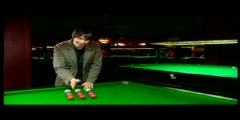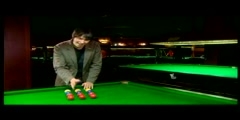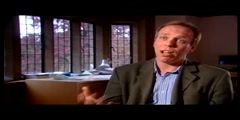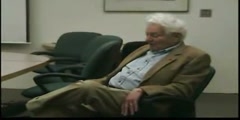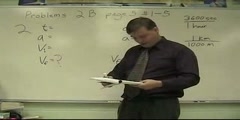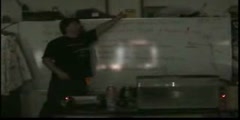Lec 31 - Physics 111: Optical Pumping (OPT)
Physics 111: Optical Pumping (OPT) Physics 111 Advanced Laboratory. Professor Sumner Davis This video accompanies the Optical Pumping Experiment, providing students with an introduction to the theory, apparatus, and procedures. This experiment is quantum mechanics in action. When two isotopes of rubidium atoms are placed in a static magnetic field, the electronic states undergo Zeeman energy level splittings in addition to fine structure and hyperfine structure. By applying polarized light at the proper frequency, we can induce transitions from ground state to excited state energy levels. The atoms then decay to higher ground state levels until we have "pumped" all of them into the same (highest) ground state energy level. Then we can see an increase in light passing through the sample because no more can be absorbed. However, when we apply a radiofrequency signal of just the right energy to stimulate transitions to a lower level, we see a sudden decrease in the radiation signal as the system is again pumped to the higher level. By determining the frequency of the RF signal we gain information about the atomic energy levels. http://advancedlab.org
Video is embedded from external source so embedding is not available.
Video is embedded from external source so download is not available.
Channels: Physics (General)
Tags: Physics 111: Optical Pumping (OPT)
Uploaded by: berkeleyphy111 ( Send Message ) on 19-09-2012.
Duration: 32m 54s
Here is the next lecture for this course
Lec 20 - Physics 111: Optical Instruments ...
51:04 | 4158 viewsLec 33 - Physics 111: Optical Trapping (OTZ)
39:21 | 3804 viewsLec 7 - Physics 111: Carbon Dioxide Laser ...
31:31 | 5785 viewsLec 11 - Physics 111: Holography (HOL)
26:23 | 4258 viewsLec 24 - Physics 111: Non-Linear Spectros ...
01:01:25 | 5371 viewsLec 25 - Physics 111: Non-Linear Spectros ...
34:46 | 4699 viewsLec 26 - Physics 111: Atom Trapping (MOT)
35:54 | 4922 viewsThe Standard Model of Particle Physics (5 ...
03:07 | 16501 viewsThe Standard Model of Particle Physics (P ...
03:07 | 17563 viewsQED -- The Jewel of Physics (12 of 15)
03:05 | 13819 viewsLec 1 - Modern Physics: Special Relativit ...
01:49:23 | 5627 viewsPhysics First with Dr. Leon Lederman
06:17 | 10227 viewsPhysics with Mr. Noon: Homework Help
07:39 | 7282 viewsPhysics with Mr. Noon: Snell's Law
09:53 | 10141 viewsPhysics with Mr. Noon: Reflection and Ref ...
09:44 | 14613 viewsNo content is added to this lecture.
This video is a part of a lecture series from of berkeley
Lecture list for this course
Lec 1 - Physics 111: Atomic Physics (ATM) Part 1. Balmer Series
Lec 2 - Physics 111: Atomic Physics (ATM) Part 2. Zeeman Effect
Lec 3 - Physics 111: Beta Ray Spectroscopy (BRA)
Lec 4 - Physics 111: Brownian Motion in Cells (BMC)
Lec 5 - Physics 111: Instrumentation Section Lab Equipment (BSC)
Lec 6 - Physics 111: Bubble Chamber (BBC)
Lec 7 - Physics 111: Carbon Dioxide Laser (CO2)
Lec 8 - Physics 111: Compton Scattering (COM)
Lec 9 - Physics 111: Gamma Ray Spectroscopy (GMA)
Lec 10 - Physics 111: Hall Effect In A Plasma (HAL)
Lec 11 - Physics 111: Holography (HOL)
Lec 12 - Physics 111: Introduction to Error Analysis
Lec 13 - Physics 111: Josephson Junction Effect (JOS)
Lec 14 - Physics 111: Radiation and Laboratory Safety
Lec 15 - Physics 111: Laser Safety
Lec 16 - Physics 111: Atomic Physics (ATM) Theory Lecture ONLY
Lec 17 - Physics 111: Energy Levels Lecture Part 1
Lec 18 - Physics 111: Energy Levels Lecture Part 2
Lec 19 - Physics 111 Light Sources and Detectors Lecture
Lec 20 - Physics 111: Optical Instruments Lecture
Lec 21 - Physics 111: Energy Transitions Lecture Series
Lec 22 - Physics 111: Laser Induced Fluorescence and Raman Scattering (LIF)
Lec 23 - Physics 111: Low Light Signal Measurements (LLS)
Lec 24 - Physics 111: Non-Linear Spectroscopy and Magneto-Optics Part 1 (MNO)
Lec 25 - Physics 111: Non-Linear Spectroscopy and Magneto-Optics Part 2 (MNO)
Lec 26 - Physics 111: Atom Trapping (MOT)
Lec 27 - Physics 111: Muon Lifetime (MUO)
Lec 28 - Physics 111: Non-Linear Dynamics and Chaos (NLD)
Lec 29 - Physics 111: Nuclear Magnetic Resonance (NMR) Part-1 Continuous Wave
Lec 30 - Physics 111: Nuclear Magnetic Resonance Part-2 Pulsed NMR
Lec 32 - Physics 111: How to do an Oral Report
Lec 33 - Physics 111: Optical Trapping (OTZ)
Lec 34 - Physics 111: Rutherford Scattering (RUT)
Lec 35 - Physics 111: Hall Effect In A Semiconductor








